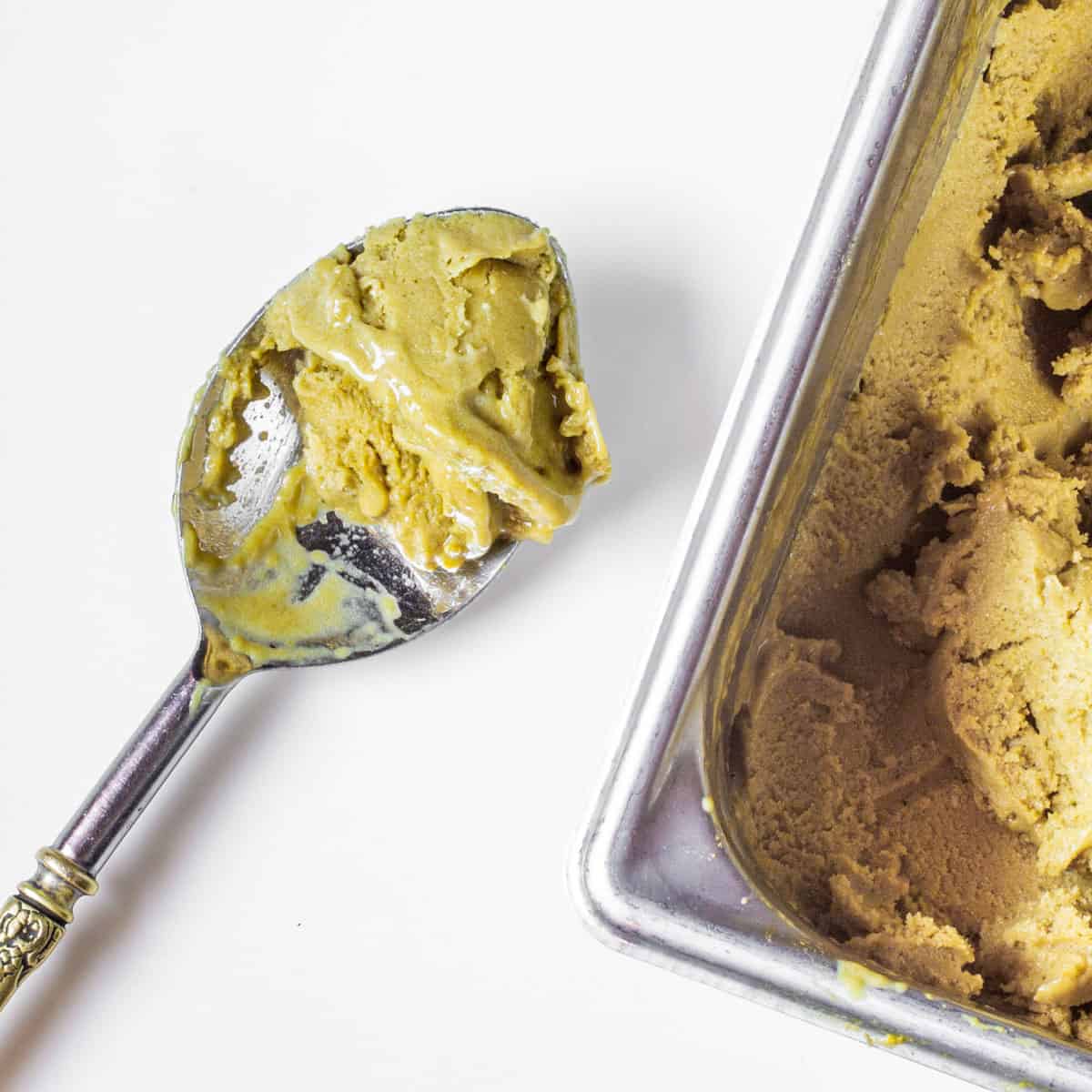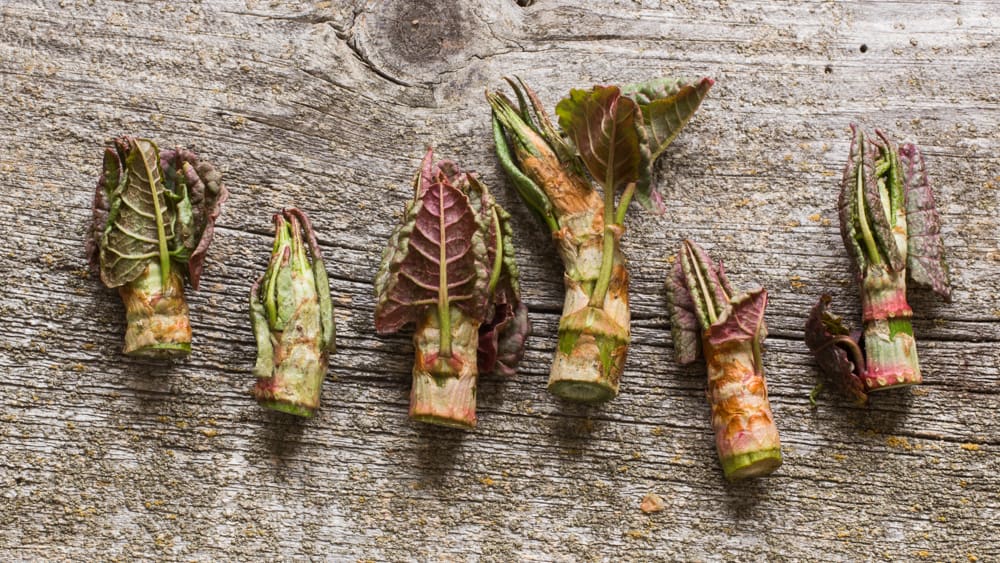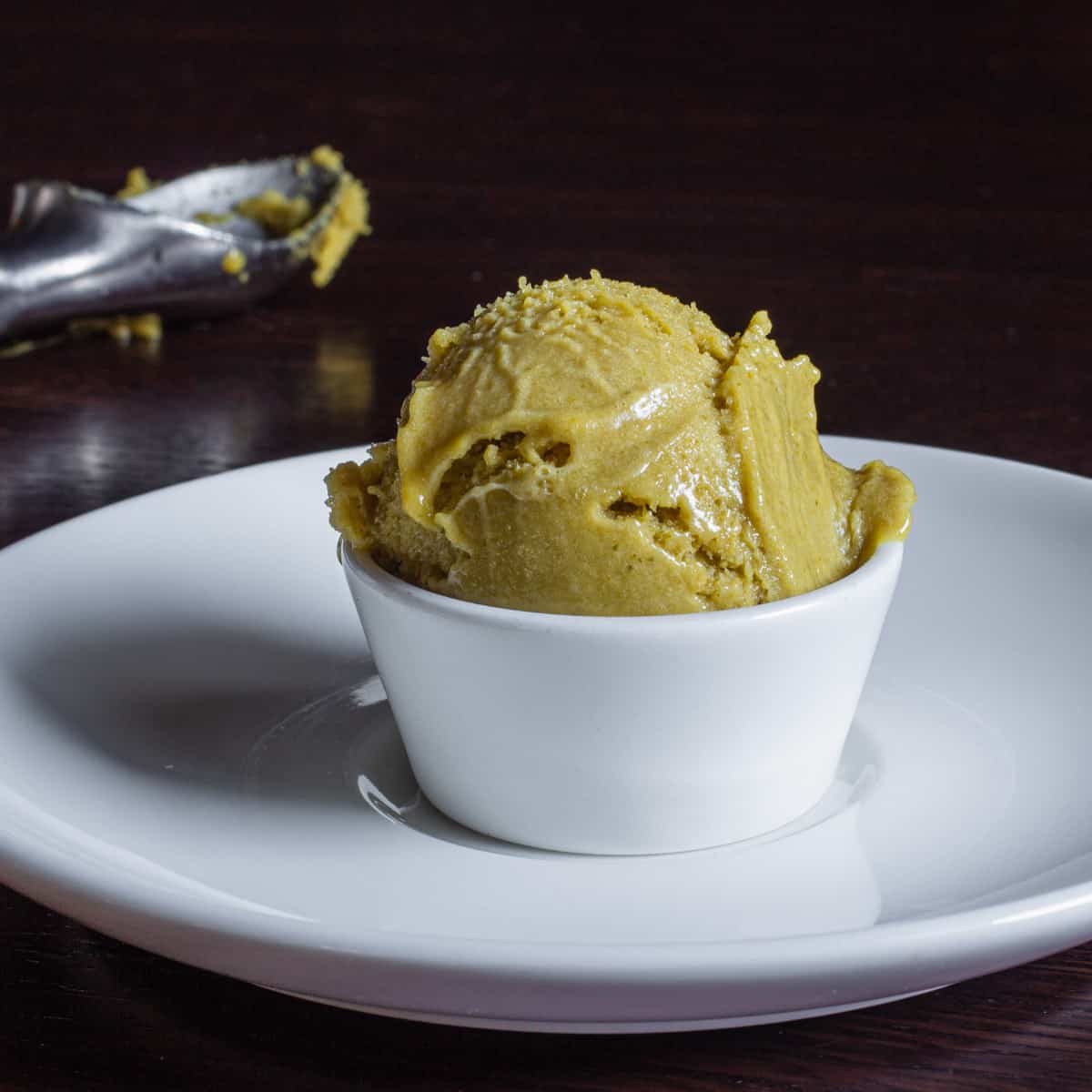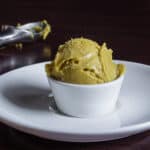A simple sorbet made from pureed Japanese knotweed shoots is one of the better desserts I've made from the plant.

I've had a lot of fun playing with Japanese knotweed, but there's was one recipe that's trumped all the others. Last year I took a vacation in San Francisco to enjoy the sights and eat at some amazing restaurants, three in particular: Coi, Saison, and Bouchon.
All of them were great (Coi and Saison were especially mind blowing) but there was one dessert course at Coi that I was reminded of when I was pureeing batches of Japanese knotweed. Of the three dessert courses at Coi, my favorite was a tiny scoop of what they were calling "frozen whipped rhubarb". The texture was so velvety, so smooth, like rich ice cream, but vegan. I'd really never had anything like it, but after tasting it, I knew that I could make something similar out of knotweed.
I waited a while before trying it, but once I did I knew I'd struck gold. The knotweed sorbet was so good that I dedicated all of the remaining puree I had in the freezer to making sorbet, and nothing else.

The only downsides, if they can really be called that are the color, and the name knotweed. Diners eat with their eyes, and a scoop of green-brown sorbet doesn't exactly scream dessert to the unadventurous.
If I've learned anything though, it's that diner's appetites rely partially on words, and the wording on a menu is like a social experiment. For example, In St. Paul, I can't sell a soup called "cream of chanterelle" to save my life, but I can definitely sell a "cream of wild mushroom" (It's the same soup, I just change the name).
So I made up a name for the sorbet, and I think it has the perfect balance of comfort and the unknown: Japanese Rhubarb. The flavor of the sorbet is a bit like rhubarb from another dimension, crossed with earthy green fruit.
To get people to enjoy it, I started bringing the sorbet to tables I speak with in the dining room for free here and there. I love to bring food to tables myself, it really helps me explain exactly what the food in question is in depth. Even with all the training in the world servers and food runners will never be able to articulate the finer points of some of the more obscure things I like to cook.
About 80% of the tables I brought it to, especially after hearing the story about it didn't just like it, they were blown away. The secret's in the fluffy texture, which mimics the frozen whipped rhubarb I had at Coi, and in combining a little bit of apple into the mix. The natural pectin in apple, as well as the mucilage of the knotweed helps to keep the sorbet soft, and also tames the heady-ness of the knotweed a bit for those who haven't had it before.
Now I have a number of regulars who ask for the Japanese rhubarb whenever they come in, it's that good.
Chef's Notes
Another interesting thing to try is processing the sorbet in the ice cream maker, but then allow it to thaw and then re-process in the ice cream maker again after it's just thawed, it incorporates air into the sorbet to help make it extra fluffy and smooth.

Japanese Knotweed Sorbet
Equipment
- 1 Blender
Ingredients
- 1 lb Japanese knotweed shoots tender young shoots only, leaves removed, washed, cleaned and peeled if possible to yield 1 lb
- ¾ cup white sugar
- 1 cup water
- Dash of lime juice to taste
- 2 green apples peeled and cored to yield about 7.5 oz
- 2 Tablespoons corn syrup
- 2 Tablespoons corn starch (optional, but helps slow crystalization)
Instructions
- Chop the knotweed and apples roughly, and if possible, pulse in a food processor to speed up the cooking process.
- Add the knotweed and apples to a 4 quart sauce pan with the sugar, water, corn syrup apples and pinch of salt. Cook on medium-high, until the apple pieces are soft, about 10 minutes.
- Continue cooking until the mixture is thick, and the cornstarch and knotweed slime have activated (slime, yum!), then transfer to a highspeed blender and puree until as smooth as possible. I like to pass it through a chinois or fine strainer at this point, especially If I’m picking older knotweed, but you don’t have to if your knotweed is very tender.
- Allow the mixture to cool to room temperature, then season with the lime juice to taste, pour into an ice cream machine and process according to the manufacturers directions.
- Mine usually spins in the machine for about 30-45 minutes. When the mixture is slightly stiff like sour cream, transfer to a container with a tight-fitting lid and freeze for at least 2-3 hours to firm. *see note
- Scoop the sorbet with an ice cream scoop dipped in hot water. If it's too firm, allow it to soften a bit, which you'll have to do if it's been in the freezer for over 24 hours.


Bridgey
Hi there, you say corn syrup in the ingredients and you write corn starch in the instructions. I think it's more likely corn starch but I'd like to make sure - can you pls confirm? thx
Alan Bergo
It's both, I made sure it reads more clearly. The corn starch is optional but helps slow crystalization, as does the corn syrup.
Bryan Wilson Bramlett
Hey you mentioned a cup of water in the ingredients but I don’t see where it’s used in the cooking process. Any insights appreciated!
Alan Bergo
Thanks I adjusted that. Add it when you're cooking the knotweed. If you use maple instead of sugar, cut the water in half.
Lori Bezahler
I finally got access to an ice cream maker and want to make this with some of the knotweed puree I have frozen. Any idea how much puree would be the equivalent of the 1lb?
Liz Terrance
Ohhhhh my gosh!!! This is so brilliant. I wish I still lived in the northeast to try this. Next to ramps, knotweed was my favorite spring green. I actually prefer it to morels 😛
I really liked it lightly balanced, and not at all sweetened. I found it took on a tomatillo taste that way, and my favorite preparation was a gazpacho.
Adonna Rudolph
....... you may not be aware that cities and municipalities all over North America are spending much time and effort in the attempt to eradicate Japanese knotweed which has shown itself to be stubbornly invasive. In our area where cities have policies forbidding the use of herbicides, the injection of Roundup into the stems of Japanese knotweed is used a last hope to kill the plants. Perhaps a caution to your readers about a side dish of round up would be in order as not all companies under contract to clear knot weed post cautions,
Alan Bergo
That's a great point. Thanks for sharing.
Jen
Isn’t a large portion of our produce in America bred to withstand high quantities of pesticide? Thinking about this now... how much round-up have I already eaten? Probably too much based on this comment alone lol
Alan Bergo
LOL. Same
Linda Foh
Fascinating! Didn't know you could do anything with knotweed. How do you make the knotweed puree?
I volunteer at Mount Moriah Cemetery in Philadelphia - an old abandoned cemetery, parts of which are overrun with Japanese knotweed. Somebody posted your article to the Friends Facebook page - partly in jest but partly serious as we would have huge amounts of it. I only see it at the end of the season when the stalks are like hollow bamboo, but the buds are popping up now.
http://friendsofmountmoriahcemetery.org/
https://www.facebook.com/groups/Fommci/?fref=nf
Alan Bergo
Make the sweetened knotweed puree by following the link in the post or by just cooking knotweed down with a touch of sugar to taste and pureeing it in a highspeed blender then straining through a fine mesh sieve.